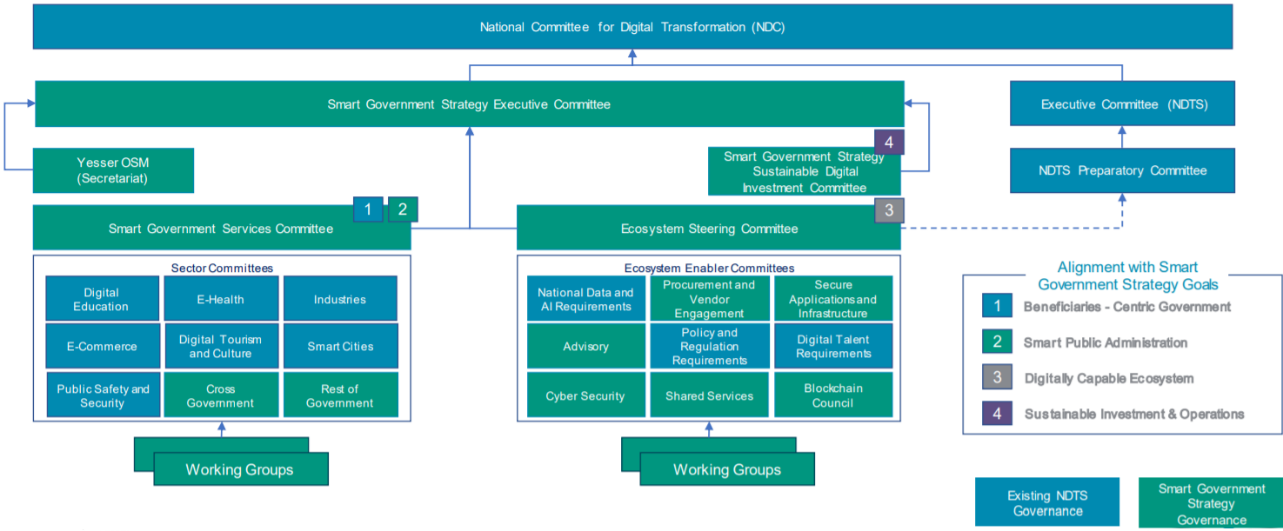Comments & Suggestions
For any inquiries or comments, please fill in the required information.
Loading...
Loading, please wait...
Home
Share The Page
The Smart Government Strategy (2020-2024) defines the Kingdom's aspiration, vision, objectives, initiatives, and action plan. Most strategic initiatives are geared towards achieving SDGs by taking actions and innovative approaches to align with the UN Sustainable Development Goals (SDGs) and the Saudi Vision 2030. The Strategy is also guided and aligned with the Saudi Vision 2030 goals and strategic objectives. The objective is to specify how the Kingdom of Saudi Arabia will deliver on its vision to digitally transform the Government and build world-class Smart Government capabilities.
The Smart Government Strategy sets an ambitious goal that, by 2024, the Government within the Kingdom will be Agile, Capable, and Innovative resulting in new seamless Smart Government experiences for the beneficiaries, centered around their needs. The Government aspirations include:
To ensure consolidation of the identified considerations and opportunities, the Kingdom has defined its aspirations to build a unified leading Smart Government that evolves around its beneficiaries - citizens, residents, tourists, and businesses alike.
Based on the ambitions and aspirations of the Kingdom, the Vision of the Strategy carries four key components that articulate Saudi Arabia's Smart Government ambitions as outlined in Vision 2030.
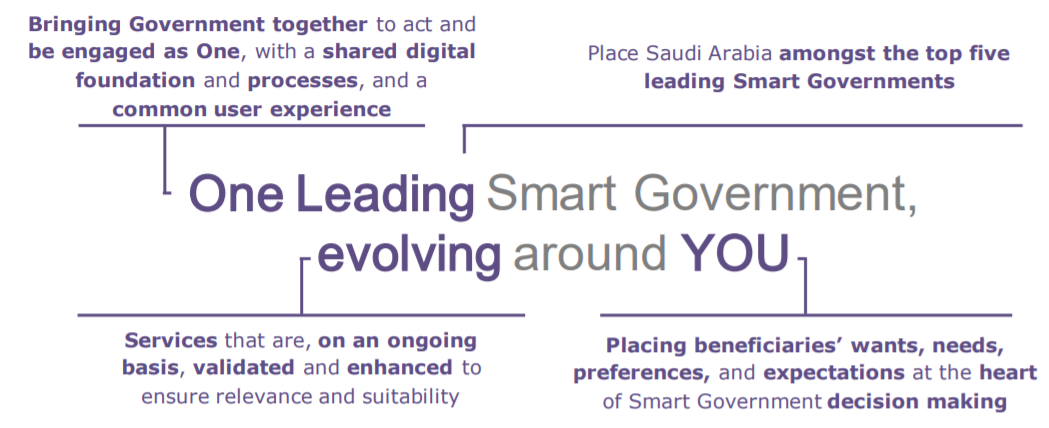
To achieve the Kingdom's aspirations and Vision, the Strategy defines four main goals and twelve strategic objectives.
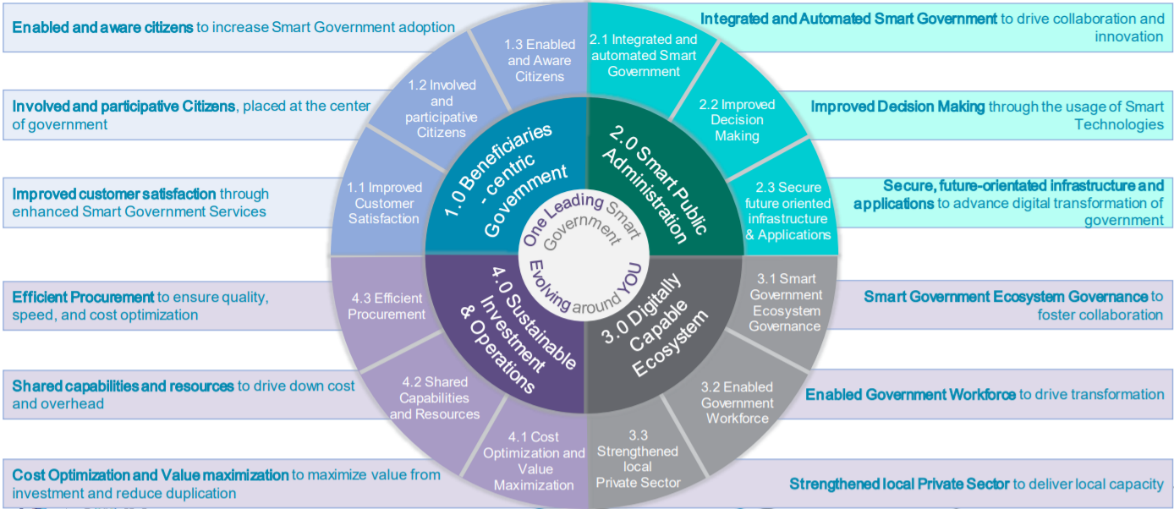
The offering of services to citizens and businesses in a targeted manner through their preferred channel, any time and any where, with the aim of delivering a rich and personalized experience that meets the needs of beneficiaries in the most intuitive way to them.
Strategic Objectives:
Establishment of Smart Administration capabilities across Government to aid better decision making, design infrastructure and systems that meet the needs of a leading smart government, and increase efficiencies based on data insights, automation and streamlining of services, and reducing repetitive manual labor. The goal will also bring the Government closer together to ideate and innovate together on the basis of leading technology capabilities.
Strategic Objectives:
Establishment of a Digital Ecosystem driving the digital transformation of Government and redefining the delivery of services through collaboration across the public and leading local private sector. This ecosystem is facilitated by a digitally capable workforce, strong processes to bring Government together and break silos and a robust market place with strong standards and controls, delivering expedited access to leading private sector capabilities.
Strategic Objectives:
Establishment of an ICT investment framework to test requested budgets and projects on Return on Investment and Value and the sustainability of solutions. In line with this, emphasize is placed on the re-use of shared capabilities across Government with the aim to reduce duplication of efforts. This framework will be supported by robust procurement guidelines and project review stage gates, ensuring control and ongoing learning and optimization.
Strategic Objectives:
The Strategy contains an implementation Action Plan for operationalization of the initiatives, implementation timeline, critical success factors, mitigations for potential risks and the following steps to activate the strategy.
The Strategy identifies three essential drivers for the Smart Government Transformation: National Drivers (Vision 2030, National Digital Transformation Strategy, and ICT Sector Strategy); Technology Drivers (Robotics & Automation, Internet of Things (IoT), Blockchain, Big Data, and Artificial Intelligence (AI)); and, Socio-Economic Drivers (Social Media and Sharing, Mobile First, DIY & Self Service Culture, Sharing Economy, and Digital Identity and Trust).
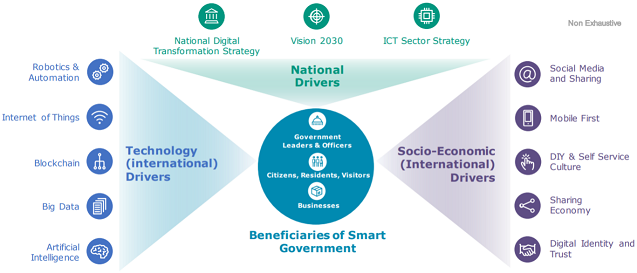
Emerging technologies are recognized as essential technology drivers for the Smart Government Strategy. The Strategy provides for using the Robotics & Automation, Internet of Things (IoT), Blockchain, Big Data, and Artificial Intelligence (AI) to achieve the Vision 2030 and Smart Government Strategy goals and objectives.
The Strategy makes reference to the adoption of Emerging technologies in four strategic objectives, each of them further operationalized by initiatives and projects.
Projects:
Projects:
Projects:
Project: Vendor Communities: Establishment of communities of suppliers in order to:
Read more about the Legal framework for Digital transformation , Emerging technology projects , Foresight Tools , and Regulatory sandbox .
The Kingdom of Saudi Arabia makes all necessary efforts to ensure digital inclusion for all its citizens and residents, including vulnerable groups such as people with disabilities, women, youth, elderly, immigrants, etc. For that purpose, the Kingdom has already joined a number of international conventions.
The question of digital inclusion and leaving no one behind is among the top priorities of the Saudi Vision 2030. The third pillar, "An ambitious nation," directly refers to the benefits and needs of the digital transformation and the need for digital inclusion of all Saudi citizens and residents. Moreover, as a Vision Realization Program, the National Transformation Program identifies several objectives directly focused on the digital inclusion of all citizens, including vulnerable groups. These objectives include:
The ICT Sector Strategy also addresses the importance of digital inclusion. The Second theme, "Increase local content," directly refers to the need for advanced technology and digital knowledge and awareness among citizens and residents. It also highlights the need for increasing female participation in the ICT sector.
The Smart Government Strategy addresses digital inclusion more specifically in Strategic objective 1.3. Enabled and aware citizens to increase Smart Government adoption. The Strategy looks to increase citizens awareness, access, and use of Smart Government services byThe eParticipation and Digital Inclusion are among the most significant priorities identified in Vision 2030 and the Smart Government Strategy.
To improve the overall eParticipation environment, the Strategy defines the Strategic objective 1.2. Involved and participative Citizens. For this purpose, the Strategy looks to increase the involvement of citizens by placing them at the center of Government by engaging them in service design and policy-making through:
The Strategy outlines two initiatives for operationalizing the Strategic objective 1.2:
The National Data Governance is one of the priorities identified in the Smart Government Strategy. Specifically, Strategic objective 2.2: Improved Decision Making through the usage of Smart Technologies looks to unleash the potential within the data held by the Government to transform how the way Government operates and increase the quality of services provided to citizens. To enable this, the Smart Government Strategy focuses on:
The Strategy defines one initiative for operationalizing the strategic objective:
Collectively these must comply with National Cyber Security, Privacy and Data Protection legislation, and the national standards for interoperability.
Saudi Arabia has already established digital identity as one of the eGovernment key enablers. All Saudi citizens and residents can create their Digital Identity (or electronic ID) by registering on the National Single Sign-On system developed by the National Information Center and the Ministry of Interior. They can use their digital ID for accessing more than 700 government online services available on my.gov.sa, other government portals, and services provided by third parties such as banks, telecom operators, etc. For more information on creating and using citizen's eID, please visit the National Information Center.
Recognizing the importance and the potential of the national digital identity, the Smart Government Strategy makes direct reference in the Strategic objective 1.1: Improved customer satisfaction through enhanced Smart Government Services. The aim is to ensure that citizens trust all government services and that their data is managed securely through a single common identity service, making digital services more secure and easy to use and enriching/automating these services by joining up the information provided by citizens through this standard digital identity across Government. The strategy defines two initiatives for operationalizing the Strategic objective 1.1:
The Saudi Arabia Government pursues a Digital-by-Default approach and aims to set up the digital communication channel as a primary by 2024 while utilizing traditional channels for those who either do not have access to the internet, do not have the relevant skills, or are in a unique situation requiring specific assistance. This means that alternative challenges will remain for assistance for particularly for users at risk of marginalization and digital exclusion.
The high level of internet penetration with approximately 98% of the population covered with 4G, with plans to have more internet coverage by 2024 and assuming a relatively high individual internet users percentage (83%), allows the Government to move the focus toward implementation of the digital by default" approach and "mobile-first" strategy. Both are identified as key priorities that can be implemented in the provision of governmental services by 2024.
Recognized as one of the drivers for Smart Government Transformation, the Smart Government Strategy provides for the adoption of a Mobile-First Strategy. The Strategy should be comprehensive, identifying required policy, process, regulatory, capability, architectural, application and infrastructure aspects needed to be put in place to establish a mobile-first approach for all KSA public sector to follow. This approach should ensure that content (while not mobile only) allows for content and services to be served via channels most used by Saudi citizens and residents.
The Once-Only Principle is recognized as one of the essential elements of the Smart Government Strategy. It is an eGovernment principle that aims to ensure that citizens and businesses only have to provide certain information to the government authorities only once (also known as a "Tell us Once Principle").
The Once-Only Principle is part of Strategic objective 1.1: Improved customer satisfaction through enhanced Smart Government Services. The aim is to ensure that citizens trust all services and that their data is managed securely through a single common identity service, making digital services more secure and easy to use and enriching/automating these services by joining up the information provided by citizens through this standard digital identity across Government, meaning that citizens only have to tell the Government once ("tell us once principle").
To operationalize the Strategic Objective, the Initiative: 1.1.1 Digital Engineering CoE leverages the capabilities present on My.Gov.Sa, the life experience framework, and the work done around the Service Design toolkit. This initiative sets up a Center of Excellence. Furthermore, it progresses KSA's journey towards beneficiaries centric and leading service delivery by implementing ten life experiences. More specifically, the initiative defines seven projects, such as Service Design Toolkit; Digital Engineering Center; Mobile-First Strategy; Customer Satisfaction; Citizen Centric Journey Development; User Experience Lab; and Digital Service Testing Framework.
The current Smart Government Strategy (2020-2024), same as the Saudi Vision 2030, is guided by the UN Sustainable Development Goals (SDGs). Most strategic initiatives are geared towards achieving SDGs by taking actions and innovative approaches to align the 2030 Agenda and the Saudi Vision 2030. The Strategy Themes and Aspirations have been directly linked to four SDGs:
TAP Theme:
TAP Aspirations:
TAP Theme:
TAP Aspirations:
TAP Theme:
TAP Aspirations:
KPI:
TAP Theme:
TAP Aspirations:
Other SDGs addressed by the Strategy include SDG 9 (Industry, Innovations, and Infrastructure), SDG 10 (Reduced Inequalities), SDG 11 (Sustainable Cities and Communities), and SDG 16 (Peace, Justice and Strong Institutions).
The current Smart Government Strategy is guided and aligned with the Saudi Vision 2030 goals and strategic objectives. The purpose of the strategy is to specify how KSA will deliver on its vision to digitally transform the Government and build world-class Smart Government capabilities, in line with the Vision 2030 goal for Smart Government.
The Smart Government Strategy is also critical to the success of several Vision Realization Programs (VRPs), such as the National Transformation Program, Quality of Life Program, National Industrial Development and Logistics Program, and Housing Program. The demands from the VRPs (over 170 initiatives are linked with Smart Government) are extensive. The need to improve government services, provide shared platforms, develop standards and regulations, and improve decision-making is amongst the key needs. All VRPs are aimed to operationalize the Vision 2030 strategic objectives.
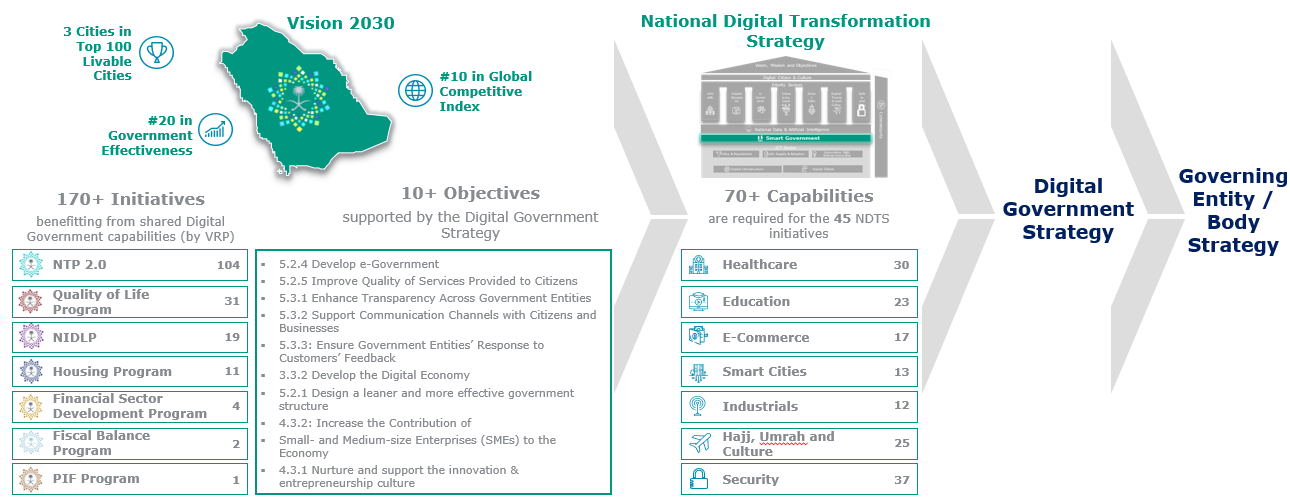
The Smart Government Strategy is also fully aligned with the other key ICT sector strategies, such as the ICT Sector Strategy, National Strategy for Data & AI, Cyber Security Strategy, Cloud First Policy, Digital Health Strategy.
The Strategy (also referred to as an eGovernment Third Action Plan) plays a vital role in the National Digital Transformation System (NDTS) in the Kingdom.
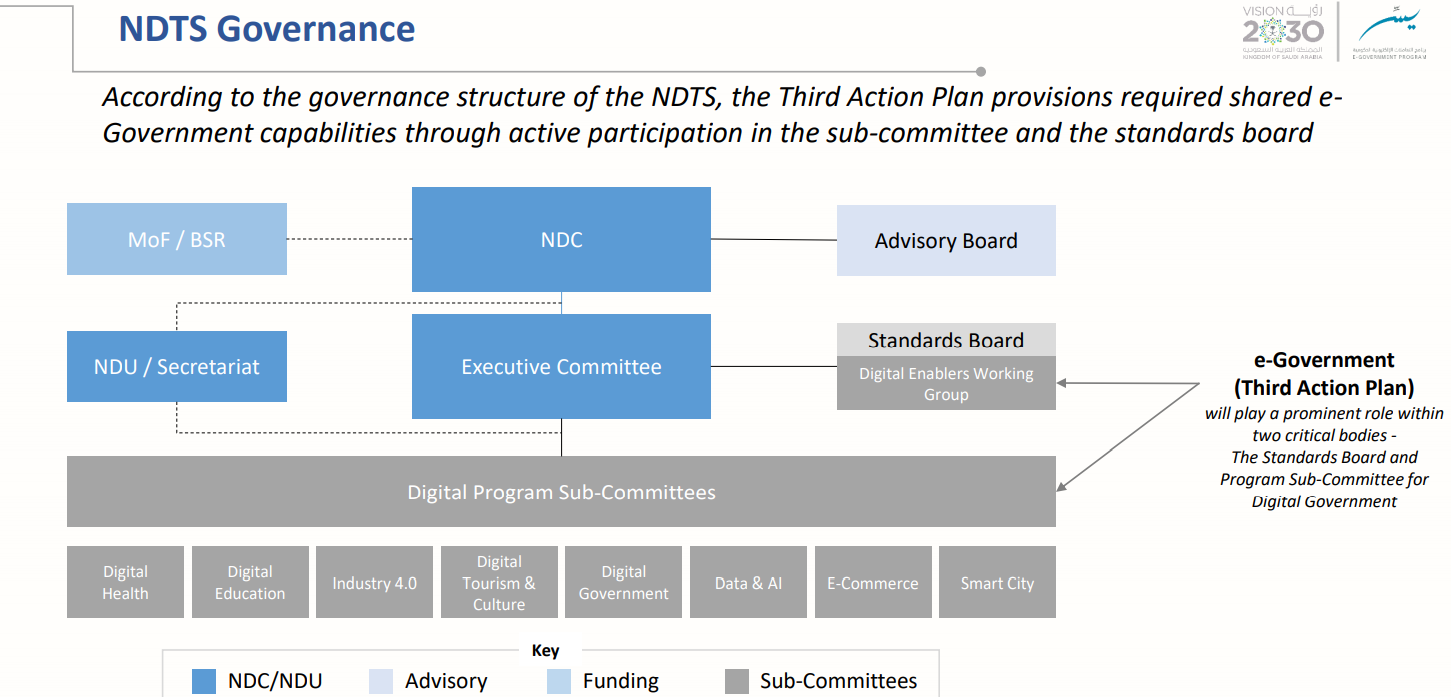
The Smart Government Strategy will be executed by a clear Governance Model that leverages NDC structures and is aligned with the Smart Government Strategy goals.
